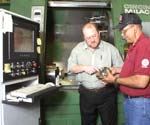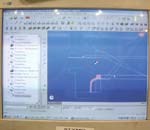At-The-Machine Programming Helps Company Keep Grip On Pump Factory Overhaul
This pump manufacturer has zeroed in on manufacturing as a primary business strategy. To ensure prosperity, the company is overhauling what it makes and how and where it's made.
Share





Like every other manufacturing segment, the industrial pump business is going through downsizing, rationalizing and consolidating. The consolidations have created new businesses such as Flowserve Corp. (Irving, Texas). Flowserve has zeroed in on manufacturing as a primary business strategy. To ensure prosperity, the company is overhauling what it makes and how and where it’s made.
An example is Flowserve Pump’s Taneytown, Maryland, factory. Flowserve acquired the plant in August 2000. Since the acquisition, change has been nonstop. Many machine tools were moved. In their places are two horizontal machining centers, a vertical turning machine, a vertical machining center and several turning centers. These machine tools are organized into 12 work cells.
Prior to this, machine tool programming was transferred to the factory floor—a management move with broad productivity ramifications. Machine tool operators became programmers. Already accountable for the quality of their work, machinists were given added responsibility for productivity.
Factory floor or at-the-machine-tool (ATM) programming allows jobs to be moved quickly between machine tools. Greg Belovic, manufacturing operations manager, and Clarence Shaw, manufacturing engineering leader, say that this kind of programming has been a major factor in keeping productivity up while the plant is overhauled. All Flowserve Pump machine tools are programmed with EdgeCAM from Pathtrace Systems Inc. (Southfield, Michigan).
To Mr. Belovic, ATM programming was a no-brainer. “Who else is better qualified to decide how a part should be machined and which tools to use than the machinist?” he asks. “ATM was also a good investment. Even counting all the additional software licenses, tooling databases, factory floor PCs, networking and CNC connections, the payback period was under a year.”
The Flowserve Pump product line includes 65 different centrifugal pumps plus flanges, drive shafts and related components. Every pump is built around Flowserve’s standard impellers (6- to 38-inch diameters) and its housings or “bowls”—all cast at Flowserve’s foundry. Production is complicated by a wide range of pressure heads, flow ratings, configurations and attachments.
Production of all these models is intertwined through 12 CNC machining cells. Eight are for turning with two turning centers in each one. The other four cells consist of a single large machine tool each—two horizontal machining centers, one vertical machining center and one vertical turret lathe (VTL). All are programmed by their operators.
Flowserve needed to do a great deal of reprogramming. Part of this resulted from bringing in a product line for which no programs were available, but most was to replace old CAM programs for existing pump components. “Hundreds of programs had to be created all over again in EdgeCAM,” Mr. Shaw notes, “often from AutoCAD drawings that were many years old.
“At-the-machine programming helped with little things, too,” Mr. Shaw points out. One example is the little variances between individual impeller castings. Machine tool operators can readily see these during visual inspection. With ATM, they quickly regenerate tool paths with new stock lines or billet lines for the start of each roughing cut.
Sharing machining programs among operators helps keep production running amid all the factory floor changes. When a program is shared, its toolpath file is run through the EdgeCAM post-processor for the second machine to accommodate differences between machine tools—M-codes, G-codes, offsets and machine parameters. Any necessary “post” re-editing is done by Mr. Shaw and John Wetzel, manufacturing engineer and CNC programmer, using Pathtrace’s Code Wizard.
“For us, EdgeCAM’s biggest benefit is being able to move programs between machines and work cells without having to redraw the model for the tool paths,” Mr. Shaw says. “Redrawing parts would be especially disruptive and is very costly.”
Post-processors are especially important to Flowserve Pump because so many of its “new” machine tools were used somewhere else for several years. “They arrived here with no posts so we are very dependent on Code Wizard,” Mr. Shaw reports. “We created some new posts quickly from similar ones we had here already, and we downloaded some from the Pathtrace Web site,” Mr. Shaw notes.
Average job size at Flowserve Pump is three to five pieces, and 25 is a big run. “We make about 100 new programs and routings a week,” he notes. If the CAM work were done anywhere else in the plant, much of the programmers’ time would be wasted hiking back and forth to the work cells.
“Some impeller modifications are so small, such as a slight adjustment in a diameter, they are done with tool offsets at the machine tool,” Mr. Shaw says.
Aside from support for ATM and good factory-floor communications, Mr. Shaw and Mr. Belovic like EdgeCAM’s tight integration with AutoCAD, Flowserve Pump’s primary CAD package. “The integration is great for importing and exporting CAD files, scaling impeller drawings up or down, and adding tool paths,” Mr. Shaw says. “Once we import AutoCAD drawing files into EdgeCAM, they pop right open.”
Much of this integration results from Pathtrace’s work in the Autodesk Inc. Manufacturing Applications Initiative (MAI) for third-party software developers. Flowserve Pump is currently running EdgeCAM Version 6.50.0.
Taking all the upheaval into consideration, Mr. Belovic and Mr. Shaw feel productivity at their plant is improving nicely.
Read Next
Building Out a Foundation for Student Machinists
Autodesk and Haas have teamed up to produce an introductory course for students that covers the basics of CAD, CAM and CNC while providing them with a portfolio part.
Read MoreSetting Up the Building Blocks for a Digital Factory
Woodward Inc. spent over a year developing an API to connect machines to its digital factory. Caron Engineering’s MiConnect has cut most of this process while also granting the shop greater access to machine information.
Read More5 Rules of Thumb for Buying CNC Machine Tools
Use these tips to carefully plan your machine tool purchases and to avoid regretting your decision later.
Read More




















.jpg;maxWidth=300;quality=90)










